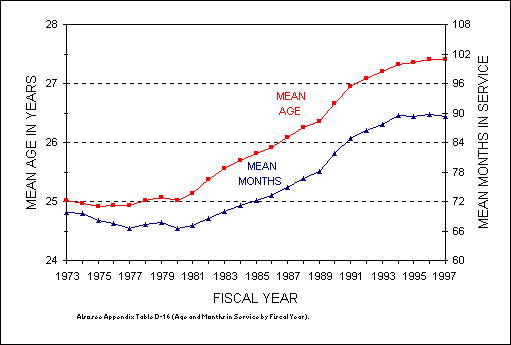|
Age. Trained person-years are more important
than end-strength when evaluating personnel readiness. Greater proportions of trained person-years reduce training costs and enable the Services to cut recruiting objectives. To gain increased person-years
with the same number of Servicemembers, DoD and Service planners increase the mean initial term of enlistment and restructure the mix of first-term and career force personnel. The mean number of months in service per enlisted Servicemember is highlighted in Figure 3.2. Mean time in service rose from 75 months in FY 1987 to 89 months in FY
1997 (an increase of 19 percent). Increased retention as well as the cumulative effect of various policies put in place since the early 1980s have resulted in an increase in mean age of the Services'
enlisted force to more than 27 years old.
 |
Figure 3.2. Active Component enlisted force average age and months in service, FYs 1973-1997.Force structure, retention, and personnel policies govern the distribution of
Servicemembers by occupation and grade. These factors have resulted in an overall DoD force profile wherein approximately half the force (51 percent) has less than 6 years of
service, with slightly less than half (45 percent) having 6 to 19 years, and 4 percent having more than 20 years.(1) Pay grade and time in service are highly correlated. Paralleling the
years in service data, pay grade distributions include slightly more than half of the
enlisted force in pay grades E1through E4 (53 percent) and slightly less than half in pay grades E5 through E9 (47 percent), as shown in Table 3.1. Progression from E1 and E2
(trainees) to E3 occurs quickly; consequently, relatively few enlisted members are in pay grades E1 and E2 (15 percent). Nearly three-quarters (73 percent) of the enlisted force is
in pay grades E3 through E6. Service differences primarily are the result of retention trends as well as the force structure and personnel requirements needed to support
Service-unique roles and missions. Thus, time in service and pay grade data should be interpreted cautiously.
Table 3.1. FY 1997 Pay Grade of Active Component Enlisted Members, by Service |
Pay Grade |
Army |
Navy |
Marine Corps |
Air Force |
DoD |
E1 |
6.8 |
6.0 |
9.2 |
3.8 |
6.1 |
E2 |
8.6 |
8.1 |
13.3 |
6.0 |
8.4 |
E3 |
13.7 |
15.7 |
28.0 |
14.5 |
16.3 |
E4 |
24.6 |
19.1 |
18.0 |
24.2 |
22.1 |
E5 |
18.9 |
21.9 |
14.3 |
26.0 |
20.9 |
E6 |
14.4 |
18.0 |
8.7 |
12.3 |
14.1 |
E7 |
9.5 |
8.0 |
5.5 |
10.3 |
8.7 |
E8 |
2.7 |
2.2 |
2.1 |
2.0 |
2.3 |
E9 |
0.8 |
1.0 |
0.9 |
1.0 |
0.9 |
Unknown |
0.1 |
* |
* |
0.0 |
* |
Total |
100.0 |
100.0 |
100.0 |
100.0 |
100.0 |
Columns may not add to total due to rounding.
* Less than one-tenth of one percent.
Also see Appendix Table B-46 (Active Component by Pay Grade and Service). |
In FY 1997, 44 percent of the enlisted force was 1724 years old, yet a little over 1
percent was older than 44, as shown in Table 3.2. For those who make the military a career, the 20-year retirement option results in many leaving service while in their late 30s
and early 40s. In the Army, Navy, and Marine Corps, a large proportion of the enlisted force was under age 25 (44, 41, and 67 percent, respectively). Marine Corps members
were the "youngest" with two-thirds under age 25, and 3 percent 39 years or older. Air Force members were the "oldest" with less than 35 percent under age 25, and 8 percent
over age 39. The Marine Corps traditionally has the youngest accessions. The Air Force experiences higher enlisted retention rates, contributing to somewhat "older" enlisted members.
Table 3.2. FY 1997 Age of Active Component Enlisted Members, by Service, and
Civilian Labor Force 17 Years and Older (Percent) |
Age |
Army |
Navy |
Marine
Corps |
Air Force |
DoD |
Civilian
Labor Force |
17-19 |
10.6 |
8.7 |
17.2 |
6.4 |
9.9 |
4.6 |
20-24 |
33.6 |
32.4 |
49.6 |
28.0 |
33.9 |
9.9 |
25-29 |
23.4 |
21.0 |
14.9 |
20.7 |
21.0 |
11.9 |
30-34 |
15.5 |
16.7 |
8.5 |
18.9 |
15.8 |
12.8 |
35-39 |
11.2 |
14.5 |
7.0 |
18.5 |
13.4 |
14.3 |
40-44 |
4.3 |
5.1 |
2.3 |
6.3 |
4.8 |
13.7 |
45-49 |
1.2 |
1.3 |
0.6 |
1.1 |
1.1 |
11.5 |
50+ |
0.2 |
0.2 |
0.1 |
0.1 |
0.2 |
21.4 |
Unknown |
0.2 |
* |
* |
* |
0.1 |
0.0 |
Total |
100.0 |
100.0 |
100.0 |
100.0 |
100.0 |
100.0 |
Columns may not add to total due to rounding.
* Less than one-tenth of one percent.
Also see Appendix
Table B-23
(Active Component by Age Group, Service, and Gender).
Source: Civilian data from Bureau of Labor Statistics Current Population Survey File, September 1997. |
While 44 percent of the enlisted force was in the 17-24 age group, less than one-sixth of
the civilian labor force fell in this range. At the other end of the distribution, one-fifth of the civilian labor force was 50 years old or older, compared with two-tenths of one percent of enlisted members.
Go to Race/Ethnicity
- See Timenes, N., Jr., Force Reductions and Restructuring in the United States, presented to NATO Seminar on Defense
Policy and Management, Brussels, Belgium, July 2, 1992. The derived force was based on the distribution by years of service from FY 1987 through FY 1989--a period of stable funding preceding the drawdown.
go back
|

